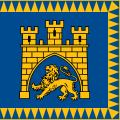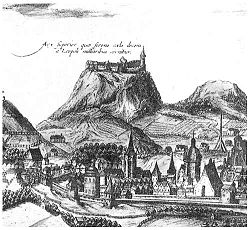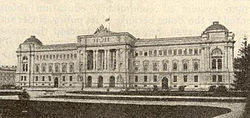Lviv
Lviv (Ukrainian: Львів) is the capital city of Lviv Oblast in Ukraine. 860,000 people live in Lviv.[2] 88% of the people living there are Ukrainian, 8% are Russian, and 1% are Polish. An extra 200,000 people commute to Lviv every day for work.
|
Львів | |
|---|---|
| Ukrainian transcription(s) | |
| • National | Lviv |
| • ALA-LC | L′viv |
| • BGN/PCGN | L’viv |
| • Scholarly | L′viv |
|
| |
| Coordinates: 49°49′48″N 24°00′51″E / 49.83000°N 24.01417°ECoordinates: 49°49′48″N 24°00′51″E / 49.83000°N 24.01417°E | |
| Country | |
| Oblast | |
| Municipality | Lviv |
| Founded | 1240–1247 |
| Magdeburg law | 1356 |
| Government | |
| • Mayor | Andriy Sadovyi |
| Area | |
| • Total | 182.01 km2 (70.27 sq mi) |
| Elevation | 296 m (971 ft) |
| Population (January 2024) | |
| • Total | 680,482[1] |
| • Density | 3,982/km2 (10,310/sq mi) |
| • Demonym | Leopolitan |
| Time zone | UTC+2 (EET) |
| • Summer (DST) | UTC+3 (EEST) |
| Postal codes | |
| Licence plate | BC (before 2004: ТА, ТВ, ТН, ТС) |
| Sister cities | Corning, Freiburg, Grozny, Kraków, Lublin, Novi Sad, Przemyśl, Saint Petersburg, Whitstable, Winnipeg, Wolfsburg, Rochdale |
| Website | city-adm |
During the city's history, it was ruled by many countries. When part of Poland it was called Lwów (pronounced and sometimes spelled Lvov). In German, it was known as Lemberg, that was part of the Austrian and Austro-Hungarian Empires and again under Nazi German occupation. From 1350 until 1772 it belonged to the Kingdom of Poland and from 1918 to 1939 to the Republic of Poland.
The mayor is Andriy Sadovyi (as of 2024).[3]
Pogrom
On 30 June 1941, the Wehrmacht German officers occupied Lviv, Ukraine. The German name for Lviv is Lemberg. Persecution of Jews began almost immediately, within just hours of the occupation, but ultimately a month later, a full-blown pogrom took place in Lviv. About 3000 to 7000 Jews were forced out of their homes, forced to do all sorts of forced labor, and were treated with great violence and also were humiliated and mocked greatly for the German officers' amusement and entertainment, in various forms. They were then sent in groups to newly-built Lwów Ghetto, and were forced to live in barracks, and used for forced labor, and then just mostly shot and killed there, in dug-up pits.
Lviv Media
High Castle first built in 1250 by Leo I of Halych and rebuilt in 1362 by Casimir III of Poland (engraving by A. Gogenberg, 17th century)
John II Casimir, King of Poland, pledging an oath at Lwów's Latin Cathedral, by painter Jan Matejko. Collection of the Wrocław Museum.
The Racławice Panorama opened in 1894
Stanisław Skarbek Theatre in 1900
The Galician Sejm (until 1918), since 1920 the Jan Kazimierz University
References
- ↑ https://city-adm.lviv.ua/lmr/lviv-community
- ↑ [1] Archived 2007-09-28 at the Wayback Machine 2001 estimate. URL accessed on June 20, 2006
- ↑ https://www.kyivpost.com/post/38423. Retrieved 2024-09-04
Other websites
![]() Lviv travel guide from Wikivoyage
Lviv travel guide from Wikivoyage















